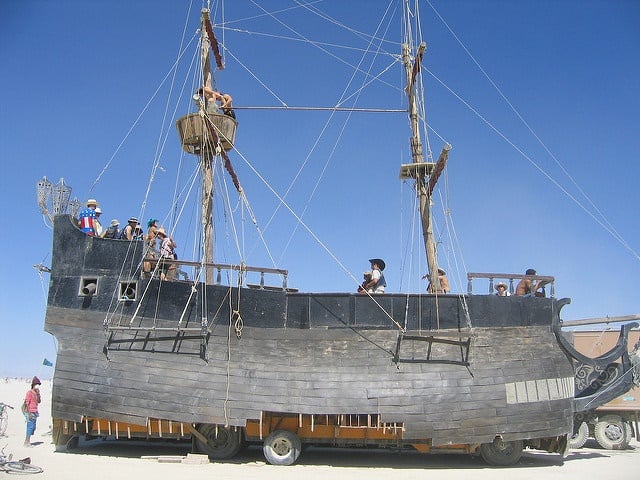
The Ninth Circuit Court in Nevada said a Nevada property owner does not owe any money to two artists for burning and scrapping a school bus they had converted into a Spanish-style galleon ship that was used for several years at the annual Burning Man Festival in the Black Rock Desert in the northern region of the state.
The decision hinged largely on the fact that the three-judge panel classified the object as “applied art” and so do not afford it the same rights that a work of “visual art” would have under the Visual Artists Rights Act or VARA of 1990, as argued by the plaintiffs.
A nighttime photo of La Contessa. Photo: Thrakazog via Flickr
The ruling also ordered that the two artists, Simon Cheffins and Gregory Jones, owed attorneys’ fees to the defendant, Michael Stewart. According to a report in Courthouse News, and a summary of the opinion online, Cheffins and Jones “transformed a used school bus into La Contessa, a mobile replica of a 16th-century Spanish galleon for use at the Burning Man Festival. After the defendant took possession of the land on which La Contessa was stored, he burned its wooden structure so that a scrap metal dealer could remove the underlying school bus from his property.”
The transformed vehicle first appeared at the festival in 2002. Festival participants took rides and at least two weddings were performed on its decks. It reappeared in 2003 and 2005. In 2003 it was used as part of a marching band performance, and in 2005 it was the centerpiece of a children’s treasure hunt.
The ruling notes it was used for transportation, “providing rides to festival-goers, hosting musical performances and weddings, and serving as a stage for poetry and acrobatics show. Indeed the La Contessa often was driven about the Festival grounds and was banned from the Festival in 2004 because ‘its unsafe driving practices far exceeded community tolerance and out-weighed the visual contribution’ it made.”
La Contessa at Burning Man. Photo: Ryan Swift via Flickr.
A federal jury disagreed with Cheffins and Jones’ original argument in 2009 that La Contessa was a visual work of art protected by VARA, Courthouse News reports. Further, Stewart had offered to settle with the artists before trial, but they declined, the report states.
One of the judges on the panel, M. Margaret McKeown took an interesting conceptual dive into the definition of “applied” vs. “visual” art with a rundown of some historical art pieces including Auguste Rodin‘s The Thinker (“it was conceived when the artist was designing a set of monumental doors titled The Gates of Hell. Doors, of course, are utilitarian objects that facilitate the movement of people into and out of buildings”).
She also mentioned Pablo Picasso’s massive tapestry Le Tricorne, which originally served as a background for a ballet and later became the focus of a preservation fight at the Four Seasons restaurant in New York (“although that painting surely served some utilitarian purpose as a stage set curtain, following that debut, it has been displayed as a painting for half a century”), and even Dale Chihuly sculptures (“fantastically artistic and original and yet could also serve a utilitarian purpose of diffusing fresh water or serving as a room divider”).
Notwithstanding our opinions on Chihuly’s artistic merits (ahem), it also got a little surreal when McKeown’s attention turned to “Bayeax tapestries depicting the Battle of Hastings, [that] still provide a utilitarian function of keeping a drafty castle warm.”
Following La Contessa‘s use at the festival, Cheffins and Jones had stored it on land owned by their friend with her permission. When the property owner’s home burned down, she abandoned the land and Stewart eventually acquired the rights to it, disposing of the piece.